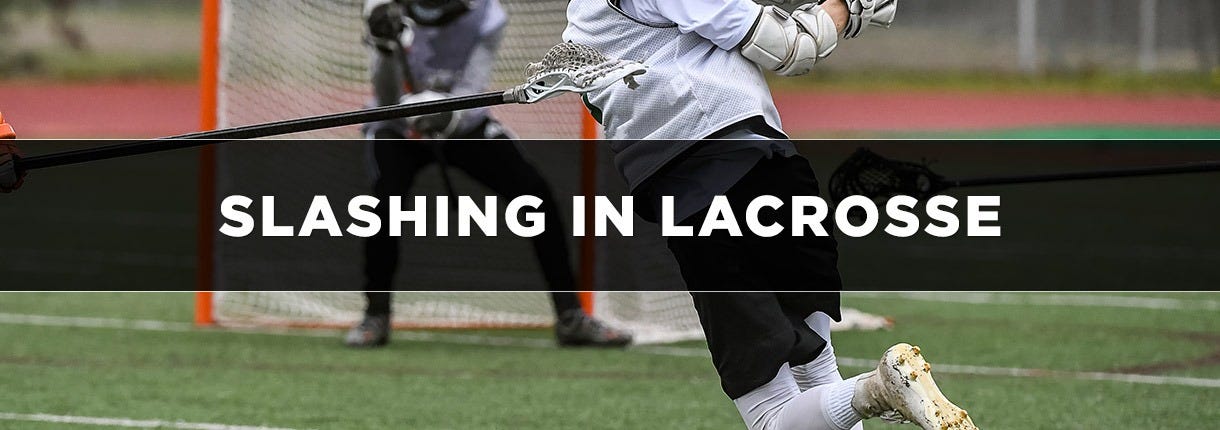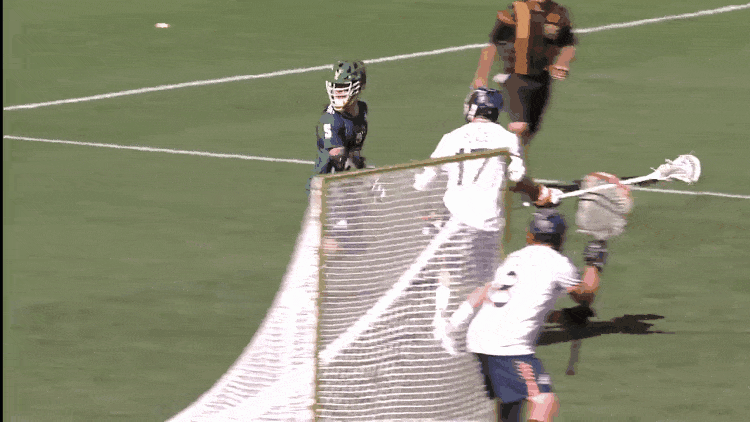Slashing In Lacrosse: What is Slashing in Lacrosse?

Slashing is defined in the rulebook as “Swinging a crosse at an opponent’s crosse or body with deliberate viciousness or reckless abandon, regardless of whether the opponent’s crosse or body is struck.” Knowing how to properly check with your stick is vital to playing defense, slashing can not only make your team man-down for up to 3 minutes, but it is also dangerous and can seriously injure another player. This article will provide a comprehensive guide on what slashing in lacrosse is.
In this article, we’ll cover:


Slashing occurs when a player is struck with a deliberate vicious check to any part of their body. Slashing penalties can result in a one to three minute penalty and can be deemed non-releasable, which means the offending player will not be released from the penalty box until the penalty time is up, even if the other team scores. Slashing to the helmet or back will result in non-releasable penalties. The slashing penalty exists to preserve player safety in the game, limiting reckless checking keeps players safe. Slashing can occur anywhere on the field, by any player including the goalie.
Slashing is defined in the rulebook as “Swinging a crosse at an opponent’s crosse or body with deliberate viciousness or reckless abandon, regardless of whether the opponent’s crosse or body is struck.” Slashing can result in a one to three minute penalty and depending on severity can be deemed non-releasable. Penalties are assessed at the referee’s discretion based on how severe the slash or intended slash is.
A. Releasable
Non-Releasable slashing penalties will result from reckless slap check attempts to the body or helmet. Non-releasable penalties are given when the referee can clearly see that the slash was reckless or was deliberate to harm another player.
B. Non-Releasable
Non-releasable slashes result in a one to three minute penalty that will not end until the penalty time expires, even if the opposing team scores multiple times. If a player commits enough slashes or other personal fouls to add up to five minutes, that player will be ejected from the game. However, if a slash is vicious enough to deem it non-releasable, the player may be ejected depending on how big the foul was.
Player safety is the number one priority in lacrosse games. The Referees do their best to maintain a fair and safe environment for both teams to compete. Slashing can be dangerous, leading to bruises, broken bones, and concussions.
Minimizing slashing starts with the coaches, players that are taught the correct way to play defense, and checking will naturally not slash as much. However, it is still up to the individual player to not slash. Lastly, the referee will always promote safe and fair play, so slashes will always be called to protect the players.
Avoiding slashing starts with playing proper defense. A defender should use their feet and body to beat an offensive player first. The stick comes second, A good defender will use less slap checks and more pokes or lifts, these will eliminate the risk of getting a slashing penalty.
- Focus on proper stick checks and defensive techniques
- Maintain control and discipline during offensive plays
- Understand the limits of physical contact and stick use
Slashing penalties can put a player in the penalty box for one to three minutes and depending on the severity the penalty could be non-releasable. Having a player in the penalty box puts your team at an immediate disadvantage, having to play man-down until the penalty is over or the other team scores. However, if the penalty is non-releasable the penalized player will remain in the penalty box until the penalty time is expired, even if the opposing team scores multiple goals. If a player slashes too many times in one game, the referee will eject them from the game.
Building good habits is vital to a lacrosse player's development over their playing career. Proper defensive techniques should be taught to players at a young age, teaching them to use less of their stick and more of their body to play defense. Playing proper defense should be supported by both the coach and the parents from a young age, helping the player build good habits for when they’re older. Additionally, The referees in youth leagues are more strict with what is called a slash which will teach young players that there are consequences for slashing as well.
Slashing is defined in the rulebook as “Swinging a crosse at an opponent’s crosse or body with deliberate viciousness or reckless abandon, regardless of whether the opponent’s crosse or body is struck.” Knowing how to properly check with your stick is vital to playing defense, slashing can not only make your team man-down for up to 3 minutes, but it is also dangerous and can seriously injure another player. Parents and coaches should encourage the players to use proper defensive techniques from a young age to build the proper defensive techniques early.
What is illegal in lacrosse?
Penalties in lacrosse include illegal body checking, slashing, cross-checking, tripping, unnecessary roughness, unsportsmanlike conduct, and the use of an illegal crosse or other illegal equipment. Any of these can result in a one to three minute penalty.
What are the consequences of slashing in a women's lacrosse game?
Women’s lacrosse involves less stick checking than men's lacrosse. So the consequences for slashing is more severe with players immediately receiving a yellow or red card.
What is considered slashing?
Slashing is defined in the rulebook as “Swinging a crosse at an opponent’s crosse or body with deliberate viciousness or reckless abandon, regardless of whether the opponent’s crosse or body is struck.”.
Is slashing a major penalty?
The severity of a slashing penalty depends on how the referee distinguishes vicious the check was, the referee can give a penalty from one to three minutes and can be non-releasable.








